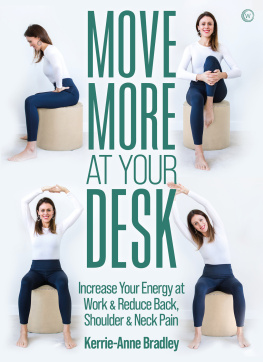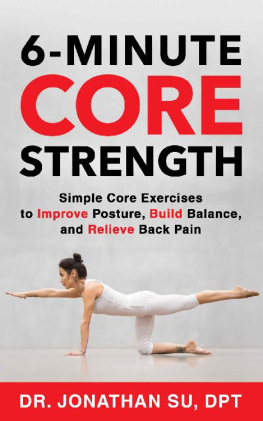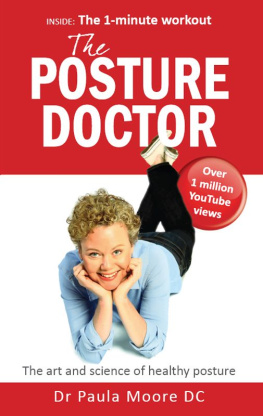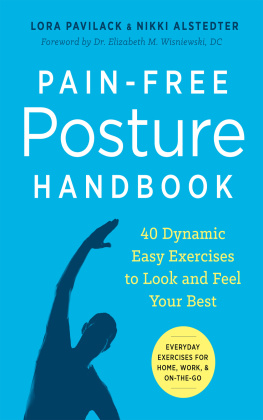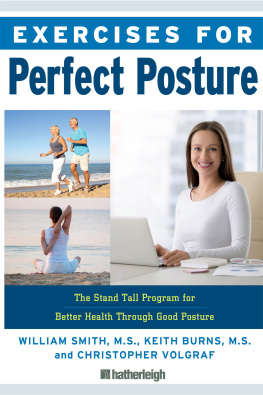The contents of this guide are based on my personal experiences as a licensed Physical Therapist and are for informational purposes only. This book does not constitute medical advice; the content of this book is not intended to be a substitute for professional medical advice, diagnosis, or treatment. Always seek the advice of a physician or other qualified health provider with any questions you may have regarding a medical condition. Never disregard professional medical advice or delay in seeking it because of something you have read on this website. Reliance on any information provided by this book is solely at your own risk.
Introduction
I have written this in order to guide people with desk jobs who are struggling day in and day out with aches and pains. Most often, these small aches and pains are curable; however, the person who suffers from them will feel like they are not. I often hear things such as, Oh I just have a bad neck, or Eh, Im just getting old. Having been a board-certified Doctor of Physical Therapy for some time now, I can tell you that these are poor reasons for a persons pain. Despite prior injuries and your age, you can always implement simple strategies to achieve a life of less discomfort and in most cases, no discomfort at all.
One type of people that I commonly treat are those who sit at a desk all day, or so they tell me. Believe it or not, in my experience, sitting for a prolonged period of time can put you in extreme discomfort and do more harm than other occupations. In most of the diagnoses I treat, there is often a culprit and a victim. What I mean is that I take into consideration the cause of a persons pain and the body part that is affected and starts to feel painful. In the case of desk jobs, I like to call sitting all day the culprit because it leads to a persons pain. Therefore, I like to refer to somebodys pain caused by sitting all day as the victim that is hurting due to the culprit.
In order for me to treat a person effectively, it is important that I treat the person as a whole. It is very simple to give a person stretch exercises and send them on their way; however, as a Physical Therapist I like to prevent these pains from coming back. As I commonly say, Treat the culprit AND the victim. I want to teach people to sit in optimal postures and provide them with additional strategies that prevent discomfort. For the best results, Ive treated the area that is hurting while providing people with strategies to keep them comfortable. Therefore, I would like to provide you with some tips and strategies that correct the daily routines causing these aches and pains. I hope that you will find this guide informative and easy to follow.
Before we begin, I would like to explain to you why bad posture at your desk can be detrimental to your well-being. When you engage in bad posture, you place your body in positions that it is not meant to be in. Doing this causes different areas of your body to hurt, and over time causes things to break down. I like to refer to a persons posture as the foundation to the house. A house foundation is essential to how a house looks and how stable it is. If a houses foundation has issues, it compromises the structure of the house and becomes one hell of a problem (not to mention an expensive one). I want you to think of your body as the house and your posture as its foundation. Without optimal posture, you may be prone to detrimental injuries down the road. My goal is to prevent that with this guide.
I would like to share some research on this subject because that is a crucial starting point. In a study by Nejati et al., the subjects working postures were compared to their forward-looking postures. The researchers concluded that the employees not only had defective postures but that improper posture was also more severe in employees that suffered from neck pain (1). I often use this study to show people the importance of posture correction because it can be applied to all office workers. I can also tell you that this is not the only study that shows the correlation between bad posture and pain. Therefore, I want to outline ways to improve your posture at work and during other activities, and give you key strategies to staying pain-free.
Finally, I would like to point out that I offer free educational videos showing exercises that improve posture on my YouTube channel Physical Therapy 101. This channel was started to provide free, to-the-point exercises to patients and practitioners. This channel is continuously being updated and provides a slew of information spanning several diagnoses, so please subscribe if you are interested. Supplemental information can be found on our website www.physicaltherapy101.net . Now, lets talk about posture!
Gravity Always Wins
E ven though you have a desk job and it might feel like you need to sit at your desk all day, it is necessary to move around. I commonly tell people, Gravity always wins. What I mean by this is that if you stay in one position for a long time, eventually gravity will pull you down towards the earth. Dont believe me? Hold your arm straight out in front of you. You should be able to do this without a problem. Now try to do this for the entire work day. I am willing to go as far as saying that nobody can hold that position for that long because eventually their shoulder will get tired. The same principle applies when you sit at a desk all day long.
As a person sits at a desk for a prolonged period of time, several things will occur. In no particular order, their shoulders become rounded and their head starts to fall forwards as well. Over time, this leads to increased tightness in the neck and chest musculature as they compensate to try and keep the head elevated, which results in pain. This also leads to weakness in the upper back musculature. When I see a person for this condition, their forward head and rounded shoulder posture is so bad that it is very obvious. Continuing down the body, a person may start to have wrist pain from a prolonged typing position. Our muscles can only support certain positions for so long before they start to get tired and cause pain.
Sitting for a long time also affects our lower body. Prolonged sitting causes a persons lower back to become rounded. Just like in the upper body, muscles try to compensate for this rounding of the lower back. Rounded back postures put extreme stress on a persons spine, especially their intervertebral discs. In fact, flexion-based postures are most commonly associated with disc herniations. Now, Im not saying that sitting for a long time will result in a disc herniation. What I am saying, however, is that due to these bad postures muscles will compensate and eventually cause pain. Moreover, like in the upper body, muscles will fatigue and become tight, which also results in pain.
Set an Alarm Every 50 Minutes
S o what can you do when you have a desk job and shouldnt sit all day? Do you just stand up? Yes, standing up is a great first step. I typically tell patients to stand up every 50 minutes; however, they often get engrossed with their work and forget. In my experience, after approximately the 50-minute mark, gravity begins to win and put people in a suboptimal posture. That is why I always suggest for a person to set an alarm so that they remember to change their position. Standing up combined with stretching your arms to the ceiling is a quick way to help fix some postural defects because it puts your body back in alignment. One thing I tell people to do in addition to standing up is to try and go for a walk. Not only does this help get you out of that bad posture, but it will also get blood flowing to your extremities. If there is one thing you take away from this guide, it should be this. Standing up and going for a brief walk is essential to preventing pain due to bad posture.



